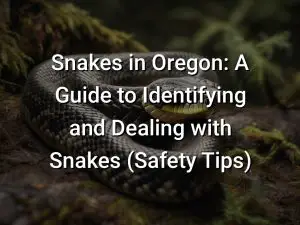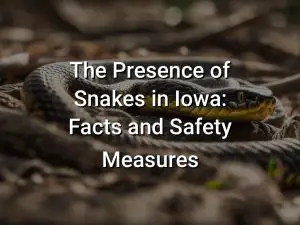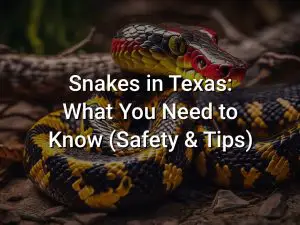Snakes in West Virginia: Common Species and Safety Tips

Snakes may not be everyone’s favorite creature, but they play an important role in the ecosystem. In West Virginia, you can find a variety of snake species, each with its own unique characteristics and behaviors. Let’s explore the common snake species in West Virginia and learn some safety tips to help you coexist peacefully with these fascinating reptiles.
From the venomous Copperhead Snake to the non-venomous Eastern King Snake, West Virginia is home to a diverse range of snakes. Understanding their habits and habitats can help you appreciate and respect these creatures while also staying safe. So, let’s dive into the world of snakes and discover the common species found in West Virginia.
Quick Links
Copperhead Snake
The Copperhead Snake (Agkistrodon contortrix) is a venomous snake that is native to West Virginia. It is named for the coppery coloration of its head, which contrasts with its darker body. Copperheads are known for their distinctive hourglass-shaped markings on their bodies, which provide camouflage and help them blend in with their surroundings.
Copperheads are most commonly found in wooded areas, rocky hillsides, and near water sources such as streams and ponds. They are generally not aggressive and will try to avoid humans, but they can bite if they feel threatened or cornered.
The bite of a Copperhead snake is venomous and can cause pain, swelling, and tissue damage. It is important to seek medical attention if bitten by a Copperhead, as the venom can have serious effects on the body.
To avoid encounters with Copperhead snakes and reduce the risk of being bitten, it is recommended to:
- Stay on designated trails and avoid walking through tall grass or underbrush where snakes may be hiding.
- Wear sturdy footwear and long pants when hiking or spending time in snake-prone areas.
- Be cautious when reaching or stepping over logs, rocks, or other potential hiding places for snakes.
- Avoid placing hands or feet in areas that are difficult to see, such as inside rock crevices or hollow logs.
- Watch where you step and use a flashlight or headlamp when walking in low-light conditions.
- Do not approach or attempt to handle a snake, even if it appears to be dead.
By being aware of their habitat and taking necessary precautions, you can minimize the risk of encountering a Copperhead snake in West Virginia.
Eastern Rat Snake
The Eastern Rat Snake, also known as the Black Rat Snake, is a common species found in West Virginia. It is a large, non-venomous snake that can grow up to 6 feet in length. The Eastern Rat Snake is typically black in color with a white or yellow underbelly.
This snake is a proficient climber and can often be found in trees or tall grasses. It is also a strong swimmer and is commonly found near bodies of water, such as rivers and streams. The Eastern Rat Snake is known for its ability to adapt to a variety of habitats, including forests, fields, and even urban areas.
The Eastern Rat Snake primarily feeds on rodents, such as rats and mice, as well as birds and their eggs. It is an important predator in controlling rodent populations, making it beneficial to have in the ecosystem.
While the Eastern Rat Snake is non-venomous, it can still bite if it feels threatened. However, it is generally a docile snake and will often try to escape rather than fight. If you encounter an Eastern Rat Snake, it is best to give it space and allow it to move away on its own.
If you are bitten by an Eastern Rat Snake or any other snake, it is important to seek medical attention immediately. Although the Eastern Rat Snake is not venomous, a bite can still cause infection and other complications.
When it comes to encountering snakes in West Virginia, it is important to remember that most snakes are harmless and play an important role in the ecosystem. If you have concerns about snakes in your area, it is recommended to contact a local wildlife agency or professional snake removal service for assistance.
Northern Water Snake
The Northern Water Snake is a non-venomous snake species commonly found in West Virginia. It is often mistaken for the venomous Northern Copperhead due to its similar appearance and habitat.
The Northern Water Snake is known for its dark brown or grayish-brown coloration, with dark blotches along the back and sides. Its belly is usually light-colored, ranging from yellow to reddish-brown, with dark markings. It has keeled scales, giving it a rough texture.
This snake species can be found in a variety of aquatic habitats, such as rivers, streams, ponds, and marshes. It is a good swimmer and can often be seen basking on rocks or branches near water bodies. The Northern Water Snake is active during the day and nocturnal, feeding primarily on small fish, amphibians, and aquatic invertebrates.
Although non-venomous, the Northern Water Snake can be aggressive and may bite if threatened or handled. It will typically release a foul-smelling musk and bite as a defensive mechanism. However, its bite is not dangerous to humans and rarely results in serious injury. It is important to give this snake species space and observe it from a safe distance.
If you encounter a Northern Water Snake in West Virginia, it is best to appreciate it from afar and not attempt to handle or provoke it. Like all wildlife, snakes play an important role in the ecosystem and should be respected and protected.
Ring-necked Snake
The Ring-necked Snake is a small, non-venomous snake native to West Virginia. It gets its name from the yellow or orange ring around its neck, which contrasts with its dark-colored body. This snake is relatively shy and prefers to hide under logs, rocks, and leaf litter.
The Ring-necked Snake is not considered dangerous to humans and rarely bites. If it does bite, its small teeth typically do not penetrate the skin. However, it is important to remember that all snakes should be treated with respect and caution.
As with any snake encounter, it is best to observe the Ring-necked Snake from a safe distance and avoid handling it. If you do come across a Ring-necked Snake or any other snake in West Virginia, it is recommended to give it space and allow it to move on its own.
Some safety tips to keep in mind when it comes to snakes in West Virginia include:
- Avoid approaching or attempting to handle snakes
- Keep your distance and allow a snake to move away
- Wear closed-toe shoes and long pants when hiking in snake-prone areas
- Be cautious when reaching into brush or moving logs, as snakes may be hiding there
- Teach children to respect and not disturb snakes
- If you encounter a venomous snake, seek medical help immediately if bitten
By being aware of the common snake species in West Virginia and following these safety tips, you can enjoy the outdoors while minimizing the risk of snake encounters.
Eastern Garter Snake
The Eastern Garter Snake is one of the most common snake species found in West Virginia. It is non-venomous and poses no threat to humans. However, if threatened or provoked, it may bite as a defensive mechanism.
Eastern Garter Snakes are typically small to medium-sized, measuring between 18 and 26 inches in length. They have a brown or black body with three yellow stripes running along their back. The stripes may be faint or vibrant, depending on the individual snake.
These snakes are found in a variety of habitats, including forests, meadows, wetlands, and suburban areas. They are excellent climbers and can often be observed basking in the sun or hiding in vegetation.
The diet of Eastern Garter Snakes primarily consists of small amphibians, such as frogs and salamanders, as well as insects and earthworms. They are not a threat to humans or pets and actually play a beneficial role in controlling populations of pests like slugs and rodents.
If you encounter an Eastern Garter Snake, it is best to observe it from a distance and not attempt to handle or disturb it. Like all wildlife, these snakes should be respected and left undisturbed in their natural habitat.
Black Rat Snake
The black rat snake, also known as the Eastern rat snake, is one of the most common snake species found in West Virginia. It is a non-venomous snake that has a glossy black color with a white throat and underside. Black rat snakes can grow up to 6 feet in length and are excellent climbers.
These snakes are often found in wooded areas, farmlands, and even residential areas. They are carnivorous and feed on rodents, birds, and other small animals. The black rat snake plays a crucial role in controlling rodent populations, making it an important part of the ecosystem.
Although black rat snakes are non-venomous, they can bite if threatened or provoked. However, they are generally docile and prefer to avoid confrontation. If you encounter a black rat snake, it is best to leave it alone and give it space to retreat.
If you have a rodent problem on your property, having black rat snakes around can be beneficial. They can help control the population of rodents without posing any threat to humans. However, if you are concerned about their presence, it is recommended to contact a local wildlife expert for guidance.
When it comes to snake encounters in West Virginia, it is important to remember that most snakes are non-venomous and prefer to avoid human contact. It is best to educate yourself about the common snake species in your area and follow safety tips to minimize the risk of snake bites.
Timber Rattlesnake
The Timber Rattlesnake is one of the venomous snake species found in West Virginia. It is a pit viper known for its distinctive rattling sound, which serves as a warning to potential threats. This species can be found in the forested areas of the state.
The Timber Rattlesnake has a broad, triangular-shaped head, a stout body, and a thick tail with rattles. It can grow to be several feet long, with some individuals reaching lengths of up to 5 feet. The coloration of this snake can vary, but it typically has a pattern of dark brown or black bands on a light brown or yellowish background.
Encounters with Timber Rattlesnakes are rare due to their shy and reclusive nature. They are most active during the warmer months, typically from April to October. During this time, they may sunbathe on rocks or logs to regulate their body temperature. They primarily feed on small mammals, such as mice and voles.
If you encounter a Timber Rattlesnake in the wild, it is important to keep your distance and give the snake space. These snakes are generally not aggressive unless provoked. If bitten by a Timber Rattlesnake, seek immediate medical attention as their venom can be dangerous and potentially life-threatening.
To minimize the risk of encountering a Timber Rattlesnake or any snake species in West Virginia, it is advisable to stay on designated trails and avoid tall grass and brush. Wear appropriate footwear, such as boots, and be cautious when reaching into or stepping over rocks and logs.
Remember, snakes play an important ecological role and are protected by law in West Virginia. It is best to appreciate these fascinating creatures from a distance and respect their habitats.
Eastern Milk Snake
The Eastern Milk Snake is a non-venomous species of snake that can be found in West Virginia. It is known for its distinctive pattern of reddish-brown or grayish-brown blotches on a light tan or gray background, which resemble the markings on a milk snake.
Eastern Milk Snakes are typically found in a variety of habitats, including forests, fields, and rocky areas. They are active during the day and are often seen basking in the sun or hunting for prey.
These snakes primarily feed on small mammals, such as mice and voles, as well as birds and their eggs. They are constrictors and will suffocate their prey before consuming it.
Eastern Milk Snakes are generally harmless to humans. They will typically try to escape or hide when encountered, but may bite if threatened or cornered. However, their bite is not venomous and is usually not dangerous.
If you encounter an Eastern Milk Snake in West Virginia, it is best to observe it from a distance and avoid handling it. It is important to remember that snakes play a valuable role in the ecosystem and should be respected and protected.
Smooth Earth Snake
The Smooth Earth Snake (Virginia valeriae) is a small and harmless snake species found in West Virginia. It is a non-venomous snake that belongs to the Colubridae family. The Smooth Earth Snake gets its name from its smooth scales and its preference for underground habitats.
Adult Smooth Earth Snakes typically grow to be around 7 to 10 inches in length. They have slender bodies and are usually gray or brown in color. The underside of the snake is pink or grayish white. They have small eyes and a small head, which allows them to burrow easily.
Smooth Earth Snakes are typically found in forested areas, grasslands, and open fields. They prefer damp habitats such as leaf litter, soft soil, and under rocks or logs. These snakes are fossorial, which means they spend much of their time underground, burrowing and searching for prey.
The diet of the Smooth Earth Snake primarily consists of soft-bodied invertebrates such as earthworms, slugs, spiders, and small insects. They locate their prey by using their sense of smell and vibration detection. Once they have found their prey, they will seize it with their small teeth and swallow it whole.
Smooth Earth Snakes are relatively shy and docile snakes. When threatened, they will typically try to escape or hide rather than bite. However, if they are cornered or handled, they may bite in self-defense. Although their bite is harmless to humans, it is always best to avoid handling wild snakes to prevent unnecessary stress or injury to both the snake and yourself.
If you encounter a Smooth Earth Snake in the wild, it is important to remember to appreciate and respect its role in the ecosystem. These snakes play a crucial role in controlling populations of pests such as slugs and insects. If you are concerned about snakes in your area or encounter a snake in your yard, it is recommended to contact a local wildlife authority or snake removal professional for assistance.
By understanding and appreciating the various snake species in West Virginia, such as the Smooth Earth Snake, we can learn to coexist with them and ensure our own safety while also preserving the natural balance of our environment.
Eastern Kingsnake
The Eastern Kingsnake is a non-venomous snake native to West Virginia. It is a powerful and robust snake, known for its ability to constrict its prey. Eastern Kingsnakes can grow up to 4 to 6 feet in length and have a glossy black or dark brown color with yellow or white bands that run across their bodies.
These snakes are predominantly found in forests, fields, and marshes, where they feed on small mammals, birds, eggs, and other snakes, including venomous ones. Eastern Kingsnakes have proven to be immune to the venom of pit vipers, such as rattlesnakes and copperheads, making them an effective predator and popular choice for snake control programs.
Eastern Kingsnakes are generally docile and non-aggressive towards humans, but they will defend themselves if threatened. They may hiss, flatten their bodies, and strike if they feel cornered or provoked. It’s important to give these snakes their space and not attempt to handle them unless you are trained and experienced in snake handling.
If you encounter an Eastern Kingsnake in the wild, it is best to observe it from a safe distance and let it continue on its way. These snakes play a crucial role in controlling rodent populations and maintaining a healthy ecosystem, so it’s important to respect and appreciate their presence.
When it comes to snake safety, always be cautious and aware of your surroundings while exploring outdoor areas in West Virginia. Learn to identify the common venomous snakes in the region and understand their behaviors to avoid any potential encounters or conflicts.
Remember, snakes play an important role in our ecosystems, and most of them are harmless and have no interest in interacting with humans. By being informed and respectful, we can coexist with these fascinating creatures and enjoy the beautiful natural environment of West Virginia.
Conclusion
Encountering snakes in West Virginia is a common occurrence due to the state’s diverse habitat. While most snakes in the region are harmless and beneficial to the ecosystem, there are a few venomous species, such as the Copperhead snake and the Timber Rattlesnake, that require caution and respect.
By familiarizing yourself with the common snake species in West Virginia, understanding their behavior, and following safety tips like staying alert, wearing appropriate clothing and footwear, and giving snakes their space, you can coexist peacefully with these fascinating creatures. Remember, snakes play a vital role in the natural balance of the environment, and with proper knowledge and precautions, you can safely enjoy the outdoors of West Virginia.






